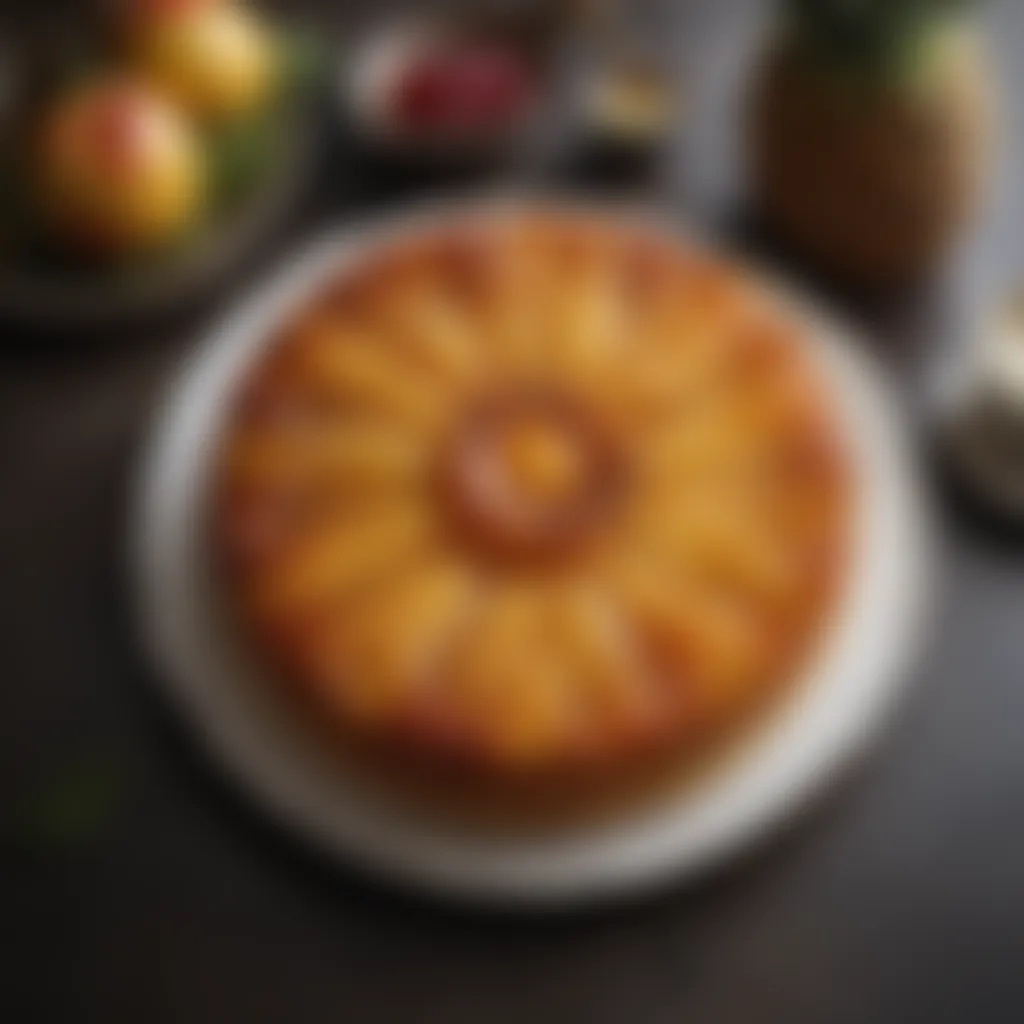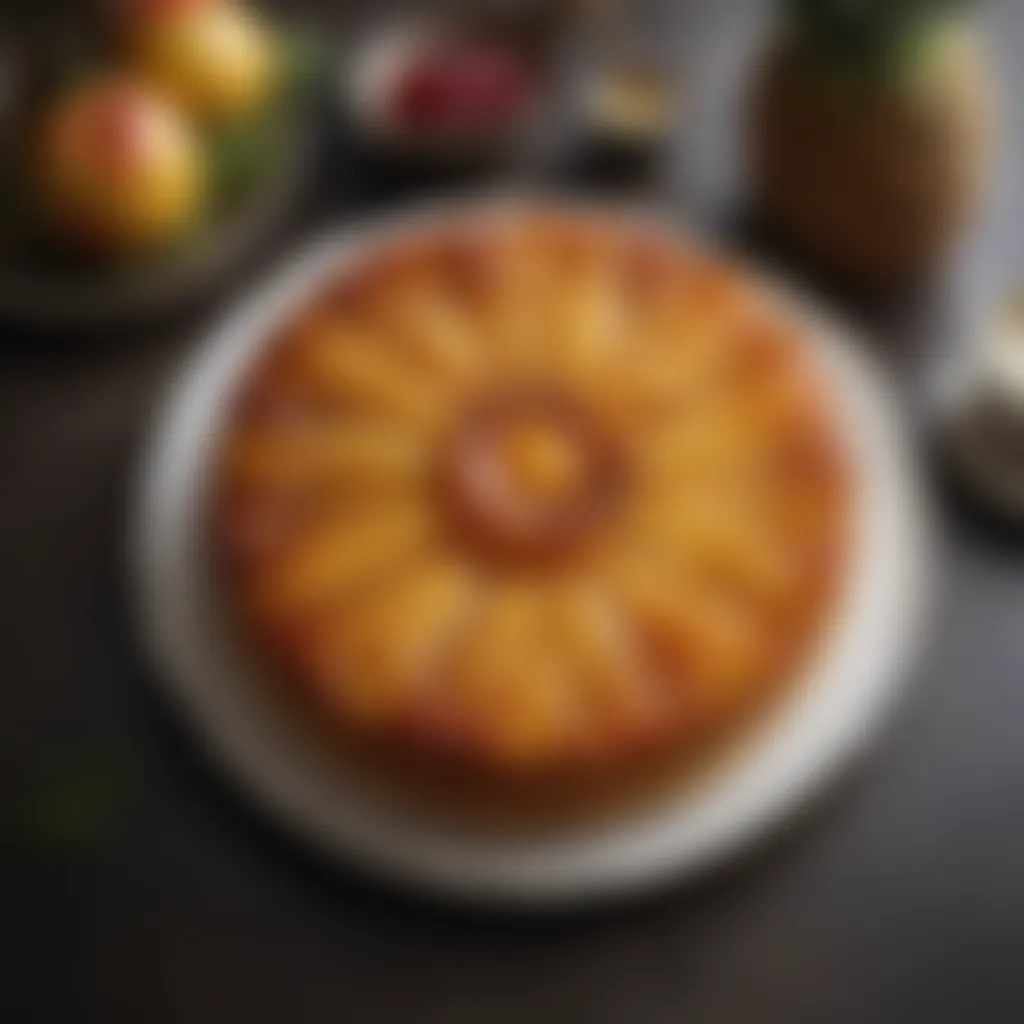Mastering the Art of Pineapple Upside Down Cake


Intro
Pineapple upside down cake isn't just a dessert; it's an experience that draws you across time and flavors. The gorgeous presentation of caramelized pineapple rounds over a tender, buttery cake creates a sensory delight. While this dish may seem simple, crafting the perfect pineapple upside down cake is an art requiring just the right mix of ingredients, techniques, and a sprinkle of love.
The roots of this iconic cake can be traced back to the 1920s, where it caught the attention of home bakers across America. In those times, the canning industry boomed, leading to a surge in fruit-oriented recipes. Today, it remains a beloved classic, often bringing back memories of family gatherings and summer picnics. That nostalgia, combined with the just-right balance between sweet and tart from the pineapple and the warm, rich cake, makes this dessert truly special.
Before diving into the nitty-gritty of making this cake, let’s first gather all the essentials.
Ingredients:
To make a pineapple upside down cake that can impress even the toughest critics, you’ll need the following ingredients:
- 1/2 cup (1 stick) unsalted butter
- 1 cup brown sugar
- 1 can (20 ounces) sliced pineapple in juice (not syrup)
- Maraschino cherries (about 10)
- 1 1/2 cups all-purpose flour
- 1 cup granulated sugar
- 1/2 cup milk
- 2 large eggs
- 1 teaspoon vanilla extract
- 1 1/2 teaspoons baking powder
- 1/4 teaspoon salt
These ingredients are sure to create a moist, flavorful cake that leaves a lasting impression. The butter and brown sugar create a lush caramel base, while the pineapple and cherries add a pop of color and flavor.
Preparation Steps:
Detailed Instructions:
- Preheat your oven to 350°F (175°C).
Getting the oven ready ensures even baking throughout, giving you a tender cake. - Melt the butter.
In a medium saucepan over low heat, melt the unsalted butter completely. Once melted, stir in the brown sugar until it dissolves. - Prepare the pan.
Pour the butter-brown sugar mixture into a 9-inch round cake pan. Arrange the pineapple slices over the sugar mixture, placing a cherry in the center of each pineapple slice. This step not only adds flavor but also elevates the visual appeal. - Mix the batter.
In a mixing bowl, combine all-purpose flour, granulated sugar, milk, eggs, vanilla, baking powder, and salt. Use a hand mixer or whisk to blend these ingredients until smooth. - Pour the batter.
Carefully pour the batter over the arranged pineapple and cherries in the pan. - Bake for 35-40 minutes.
Keep an eye on it and do the toothpick test. Insert a toothpick in the center; if it comes out clean, your cake is ready. - Cool and invert.
Allow the cake to cool for about 10 minutes before inverting it onto a serving plate. This step is crucial to avoid losing any of that caramelized pineapple topping.
Technical Aspects:
Baking requires precision. Here are some key technical aspects to keep in mind:
- Temperature Settings: Ensure your oven is fully preheated. An unheated oven can lead to uneven baking.
- Timing Specifics: Stick to the recommended baking time, but every oven is unique. Use a timer but rely mainly on visual cues and the toothpick test.
- Critical Techniques: Careful arrangement of the pineapple and cherries will enhance the outcome. Ensuring that the butter-brown sugar mixture is bubbly before adding the batter is also crucial for caramelization.
Cooking Process:
Sequential Steps:
- Prepare the pan as mentioned above. This foundational step is key.
- Mix together the ingredients as per instructions. Proper mixing is vital to achieve a smooth batter.
- Control the oven temperature and baking time, adjusting as necessary.
Troubleshooting Tips:
Even the best bakers can face hiccups. If things don’t go as planned, here’s what to do:
- If the cake is too dry: Consider adding a little more milk next time or check baking times.
- Burnt edges: Lower the oven temperature slightly if this happens in subsequent attempts.
- Pineapple slices stick to the pan: Make sure you thoroughly coat the pan with the butter-brown sugar mixture.
Mastering the pineapple upside down cake isn't just about the flavors; it speaks to tradition and evokes cherished memories. Understanding the ingredients and techniques will surely place you on the path to baking a cake your loved ones will savor.
Historical Context of Pineapple Upside Down Cake
The pineapple upside down cake is not just a dessert; it embodies a story of American culinary evolution, cultural exchange, and the innovative spirit of home bakers. Understanding the historical context gives depth to this beloved cake, revealing how it came to be a staple at celebrations, potlucks, and family dinners. Plus, it helps bakers choose ingredients and techniques that honor the cake's origins while allowing for personal flair in the kitchen.
Influences from American Cuisine
The roots of the pineapple upside down cake can be traced back to the early 20th century, around the time when canned goods were becoming a household staple. What better fruit to showcase than the pineapple, which symbolizes hospitality? The cake itself reflects the resourcefulness of American homemakers. Access to canned pineapples not only made this cake easier to prepare but also made the exotic fruit accessible to many households.
Most importantly, the introduction of pineapple into desserts revolutionized baking practices at that time. The sweetness and tartness of the fruit combined beautifully with the buttery, rich base, enriching American baked goods repertoire with tropical flavors that had previously been unlikely. The combination of simplicity and deliciousness put this cake on the radar of many, leading to its eventual fame across the country.
Cultural Significance of Pineapples
In many cultures, the pineapple symbolizes warmth, friendship, and hospitality. In the American context, it is often seen as a representation of welcoming and comfort—values that have shaped much of the nation's social interactions. Beyond its aesthetic appeal, the pineapple carried over connotations of exoticism and luxury, particularly in the United States around the time of its rise to fame in home kitchens.
Using pineapple in desserts was more than just about taste; it was about elevating the ordinary. When a cake topped with shiny candied pineapple slices was brought out at a gathering, it was more than a treat; it was a statement of care and celebration. For many housewives in the mid-1900s, creating a pineapple upside down cake was a way to convey a sense of occasion and hospitality, harnessing the fruit's cultural significance as they baked.
The Evolution of the Recipe
As home cooks embraced this cake, the recipe naturally began to adapt and change, a testament to the inherent creativity found in the kitchen. The initial recipe was fairly simple: a layer of caramel, sliced pineapple, and a light sponge cake. Over time, variations emerged. Some bakers swapped out the traditional butter with margarine, while others experimented with different fruit toppings or added spices like nutmeg and cinnamon to the batter.
Today, the recipe may be altered to suit personal preferences or dietary needs, leading to gluten-free or vegan versions of the classic. The pineapple upside down cake has not only survived the test of time but has thrived through innovation and reinterpretation, reflecting the changing culinary landscape.
From its humble beginnings to a celebrated dessert, the pineapple upside down cake continues to be a delightful homage to the history of American baking, one that can be explored and appreciated in each slice.
Understanding Ingredients


In the world of baking, particularly when it comes to pineapple upside down cake, ingredients can make or break your efforts. Each component plays a pivotal role in not only influencing taste but also the texture and overall satisfaction of the cake. The interplay of ingredients is more than just a checklist; it's an art form that transforms a simple dish into a culinary masterpiece. Understanding the nuances of each ingredient helps you become more intentional in your cooking. This section delves into critical elements that make up this delicious dessert, equipping you with knowledge that ultimately enhances your baking skills.
Pineapples: Fresh vs. Canned
Selecting the right type of pineapple is foundational. The choice between fresh and canned goes beyond mere convenience. Fresh pineapples promise an unmatched sweetness and vibrant flavor. Their juicy texture can elevate the whole cake experience. However, they need preparation, including peeling, coring, and slicing, which can be a chore for some.
On the flip side, canned pineapples bring ease. They're pre-cut, handy, and come drenched in syrup, which can contribute to the cake’s moisture. But beware; they may lack the full flavor profile of their fresh counterparts.
Consider this: For a stunning presentation and optimal flavor, opt for fresh whenever possible, but have a can on standby for those unforeseen baking emergencies.
Types of Sugar and Their Effects
Sugar serves not only as a sweetener but also plays an intricate role in the cake's structure. Common choices include granulated sugar, brown sugar, or even alternatives like coconut sugar. Granulated sugar is often used for its neutrality, allowing other flavors to shine. Brown sugar, in particular, can give your cake a rich, caramel-like depth due to its molasses content. This can greatly affect the cake's moisture level and texture, lending a denser, chewier bite.
Here are some factors to consider:
- Flavor: Brown sugar can enhance depth, while granulated sugar offers a clean sweetness.
- Texture: Using too much brown sugar can create a heavier cake, while granulated may yield a lighter outcome.
Butter Quality and Its Impact
Butter is one of those ingredients that doesn't play solely a supportive role. The quality here is key. Higher-fat butters, like European varieties, often result in a more luxurious cake with a tender crumb. Butter not only contributes to moisture but also invites rich flavors that permeate the entire cake. When you use salted vs. unsalted butter, remember this: unsalted gives you control over salt levels, essential for achieving a balanced taste. The best practice? Always use room-temperature butter for ease of mixing, ensuring it incorporates well into the batter for a light and fluffy textural experience.
Flour Varieties in Baking
The choice of flour may seem straightforward, yet it can dramatically alter your cake's fate. All-purpose flour is a jack-of-all-trades, suitable for most recipes. However, using cake flour can elevate your creation, thanks to its lower protein content which leads to a more tender cake.
To help guide your selection:
- All-purpose flour: Versatile and readily available, suitable for everyday baking.
- Cake flour: Produces softer, airy textures due to its fine grind.
- Whole wheat flour: Adds a nutty flavor, but can make the cake denser if not balanced right.
In summary, understanding these ingredients is fundamental to mastering pineapple upside down cake. You can't afford to overlook their role; the right balance can turn an ordinary cake into something extraordinary.
Delving deep into these choices is the first step toward creating a moist, flavorful delight that resonates on a plate. The next step is to consider how to utilize these ingredients effectively in your preparation.
Essential Equipment for Baking
When it comes to crafting a pineapple upside down cake, the right tools can be the difference between a cake that wows and one that falls flat. Having the essential equipment not only makes the process smoother but also ensures that the final product has the desired texture and flavor. Let's explore which elements matter most and how they contribute to the art of baking.
Choosing the Right Bakeware
Bakeware stands as the foundation of any great baking venture. When selecting bakeware for your pineapple upside down cake, the material matters. Aluminum pans are particularly effective, as they conduct heat well, promoting even cooking. Glass or ceramic dishes, while they may look lovely for serving, can sometimes lead to uneven baking. If you're leaning towards something visually appealing, ensure the inner surface is dark or nonstick.
Another consideration is the size of the pan. A standard 9-inch round pan is ideal for this recipe, allowing enough space for the caramel and fruit topping to set perfectly. And don't overlook the importance of shape; a removable bottom pan can help with the flipping process, minimizing the chances of a cake catastrophe.
Utensils That Matter
Baking isn't just about ovens and pans; having the right utensils can spell success. Start with a reliable mixing bowl. A large, sturdy bowl will allow for proper mixing without risking spills. Next, invest in a whisk and a good spatula. A whisk is your best friend for aerating the batter, while a silicone spatula helps fold ingredients and scrape down those pesky sides, ensuring an even mix.
Don’t forget about a set of measuring cups and spoons. Precision is key when crafting this cake. Incorrect measurements can skew texture and flavor. Think about making life a little more straightforward by using a kitchen scale for the dry ingredients too; this can add accuracy and take the guesswork out of the equations.
Temperature Control: Ovens and Thermometers
In the baking arena, temperature control is paramount. The first step? Get to know your oven. Not all ovens are created equal. Some run hot, while others may be a bit on the colder side. An oven thermometer can be a game-changer here, enabling you to maintain accuracy throughout the baking process. Without precise temperature settings, even the most exquisite batter can end up dense or overcooked.
When baking a pineapple upside down cake, managing the temperature not only impacts doneness but also influences the caramelization of sugar in the topping. Aim for a steady temperature of around 350°F. Keeping it consistent allows flavors to meld beautifully, creating a caramel that’s rich and divine.
"A well-equipped kitchen leads to better outcomes, transforming a simple recipe into a culinary masterpiece."
Investing time and resources in understanding and selecting the right equipment is vital for any aspiring baker. Each item in your kitchen serves a purpose, turning what may seem like a simple cake into a well-executed delight. So, before diving into those mixed ingredients, make sure your kitchen is ready for the task ahead.
Preparation Techniques
When it comes to crafting a stellar pineapple upside down cake, the preparation techniques are essential. This crucial stage lays the groundwork for the final product, ensuring flavors meld and textures harmonize. Getting these techniques right can make the difference between a cake that's merely good and one that's downright extraordinary.
A solid understanding of preparation not only boosts your confidence as a baker but also enhances your ability to troubleshoot any issues that may arise. For example, if the caramel doesn’t form correctly, it can lead to a disappointing soggy base, which no one wants.
Focusing on each preparation aspect helps you appreciate the artistry behind this dessert. It’s not just about following a recipe; it's about understanding why you’re doing each step.
Making the Caramel Base


Creating the caramel base is one of the most critical aspects of the pineapple upside down cake. The caramel acts as the foundation, providing sweetness and richness. To craft a perfect caramel, start by combining equal parts sugar and butter in your baking pan over medium heat. This method allows for an even melt, reducing the risk of burning.
- Stir constantly until the mixture turns a beautiful golden brown.
- Depending on your preference, you can even add a splash of vanilla or a pinch of salt for extra flavor.
Tip: Timing is everything! Once the caramel is ready, arrange your pineapple slices and cherries quickly, so it doesn’t harden before you’re ready.
Arranging Pineapple and Cherries
Once your caramel base is ready, arranging the pineapple slices and cherries is both a delight and an art form.
- Start by laying out your pineapple slices in the caramel. Choices here matter—fresh pineapple offers a bright and vibrant flavor, while canned pineapple rings provide convenience and consistent sweetness.
- Don’t forget to place a maraschino cherry in the center of each pineapple slice for that classic touch.
- For a little bit of flair, consider adding toasted pecans or walnuts around the pineapple for additional crunch and flavor.
This step is not just decorative; it’s about maximizing flavor. As the cake bakes, the fruit infuses its natural juices into the batter, creating a lush, moist experience that will have everyone coming back for seconds.
Batter Mixing Best Practices
The way you mix your batter can greatly affect the cake’s texture. First off, ensure your ingredients are at room temperature—this helps them combine more seamlessly.
- In a large bowl, cream together softened butter and sugar until light and fluffy, about 5 to 7 minutes.
- Gradually incorporate eggs, one at a time, mixing well after each addition.
- Sift together the dry ingredients—flour, baking powder, and a pinch of salt—then alternate adding them with milk to the wet mixture. This method helps prevent overmixing.
Overmixing can lead to a dense cake that lacks that airy fluffiness everyone loves. Aim for just combined—some small lumps are perfectly fine.
Baking the Cake
Baking the cake represents the crescendo in the symphony of creating a pineapple upside down cake. It's where all previous efforts come together to manifest an edible masterpiece. The process requires precision and awareness of several factors, all culminating in the eagerly awaited moment when you allow your creation to share the spotlight on your dining table. In this section, we’ll explore vital considerations such as timing and temperature, and how these elements affect the final outcome of your cake.
Timing and Temperature Guidelines
Getting the timing and temperature right is akin to the alchemy of baking. It’s this specific dance that turns raw ingredients into a scrumptious cake. First, let’s discuss the baking temperature. Generally, the ideal temperature for baking a pineapple upside down cake hovers around 350°F (175°C). This allows the cake to bake evenly without burning the fruit topping.
- Preheat Your Oven: Always heat your oven in advance. It sets the stage for even cooking from the get-go. A hot oven helps achieve that much-desired caramelization of the sugar in the topping.
- Timing is Everything: For a standard-sized cake, you can expect the baking time to range from 30 to 40 minutes. However, times can vary based on your oven's quirks, so keep a close eye on it.
- Know Thy Cake: An important tip is to note that cakes in darker pans may bake faster than those in lighter ones. Adjust your timing accordingly.
The use of an oven thermometer can be a game changer. With fluctuating oven temperatures, knowing your actual temperature can make the difference between success and a soggy mess.
Signs of Doneness
After waiting with bated breath, the key to knowing when your pineapple upside down cake is ready comes down to a few tell-tale signs. None is more crucial than the classic toothpick test.
- Toothpick Test: Insert a toothpick into the center of the cake. If it emerges clean or with a few crumbs clinging to it, your cake's good to go! If it’s gooey, it needs a few more minutes.
- Golden Brown Top: Look for that appetizing golden brown crust on the top. This not only indicates a nicely cooked cake but adds to the overall aesthetic.
- Springy to Touch: When you gently press the center of the cake, it should bounce back. If it doesn’t, it likely requires additional baking time.
To sum it all up, paying careful attention during the baking phase of your pineapple upside down cake journey will guide you toward a successful finale. The right timing, temperature, and recognizing the signs of doneness are your tools for crafting a cake that isn’t just a dessert, but a delicious sensation.
Post-Baking Considerations
After investing time and effort into making your pineapple upside down cake, it is essential to understand the critical elements of post-baking. These considerations not only influence the final presentation but also affect the overall taste and texture of the cake. Proper cooling techniques and serving methodologies can elevate your baked creation from merely good to truly outstanding.
Cooling Techniques
Cooling may seem like a mundane task, but it plays a vital role in ensuring your cake maintains its structure and flavor. Rushing through this stage can lead to disaster, so take heed of the following guidelines:
- Let it Rest: Allow the cake to cool in the pan for at least 10-15 minutes. This resting period lets the caramel set, ensuring it does not seep away when inverted.
- Temperature Control: After the initial cool down, transfer the cake to a wire rack. This step promotes airflow around the cake, preventing any undesirable sogginess. Placing it on a solid surface might trap moisture.
- Avoid the Fridge: While it might be tempting to pop the cake into the refrigerator for a quicker cool down, resist this urge. Cold environments can cause the cake to harden and change its texture, not to mention the risk of condensation causing a soggy top.
It’s worth noting that a well-cooled cake is easier to slice and serve. A cake that is too warm might crumble, leaving you with a plate of confusion rather than a beautifully arranged dessert.
Flip and Serve Methodology
Flipping and serving your pineapple upside down cake is where the magic happens, allowing your beautiful pineapple and cherry arrangement to shine. Here’s how to do it with finesse:
- Prepare for the Flip: Before inverting, make sure the cake has cooled adequately. Gently run a knife around the edges of the pan, ensuring nothing is sticking.
- Choose Your Surface: Decide on a serving platter that can comfortably accommodate your cake. A slightly larger plate gives you room for any runaway toppings.
- Inversion Technique: Place the serving plate upside down on the top of the cake. With a swift movement, flip both the plate and the pan together, allowing the cake to land gently on the plate.
- Gentle Tapping: Sometimes, you might need to tap the bottom of the pan lightly to help the cake release, but be cautious not to damage the delicate caramel layer or fruit.
- Finishing Touch: Once flipped, take the time to reposition any fruit that may have shifted during the process. A little adjustment goes a long way in presentation.
Remember: Patience is key when flipping. It may take a few tries to master the technique, but with practice, you'll find the right rhythm that works for you.
Successfully flipping and serving your cake concludes the baking process, allowing you (and your guests) to appreciate the beauty and flavors of your hard work. By following these post-baking considerations, you can bring your masterpiece to the table with confidence.
Variations on the Classic Recipe
The beauty of the pineapple upside down cake lies in its adaptability. While the traditional recipe holds a special place in many hearts, experimenting with variations not only keeps the dessert fresh and exciting but also allows home bakers to tailor it to their personal preferences and dietary needs. These deviations can introduce new flavors, textures, or even enhance health benefits without compromising the classic essence of this beloved treat.


Incorporating Different Fruits
Imagine swapping those familiar pineapple rings for a rainbow of fruits. Pears, for example, can add a softer texture and mild sweetness. They pair nicely with a hint of cinnamon, elevating the overall flavor profile. You could also try peaches, which, when caramelized, impart a beautiful golden hue and their juicy nature can lend a refreshing taste. Another excellent option is mango, which introduces a tropical twist and balances out the cake’s richness. As you get creative, remember that each fruit has its distinct moisture content and sweetness level, which can influence the final product.
- Keep the basic preparation methods intact, but be mindful of adjusting sugar levels based on the sweetness of your chosen fruit.
- When using fruits with high moisture content (like watermelon), consider partially drying them out before incorporating them into the caramel base. This will prevent the soggy bottom that often plagues variations.
Adapting the cake to include different fruits allows for the creation of a seasonal sensation. For instance, in summer, cherries and berries can create a vibrant and festive look. In autumn, apples and figs could be the perfect fit to invoke a cozy vibe.
Gluten-Free and Vegan Adaptations
Not everyone can partake in the classic recipe due to dietary restrictions; hence, offering gluten-free and vegan adaptations opens the cake's joys to a wider audience. For a gluten-free version, simple substitutes like almond flour or coconut flour can be employed. They not only eliminate gluten but also introduce interesting flavors. Keep in mind that these flours behave differently, so adjustments in moisture or binding agents, like adding flaxseed meal or chia seeds combined with water, can help achieve the desired texture.
On the vegan front, replacing eggs is made easy with alternatives such as applesauce, mashed bananas, or silken tofu. These substitutes offer moisture and binding properties, allowing you to maintain the integrity of the cake without animal products.
- Always check your baking powder to ensure it is gluten-free when making the switch.
- Opt for plant-based butter for a creamy texture that brings richness without dairy.
Both gluten-free and vegan cakes can yield delightful results if executed with care. The texture might differ slightly from that of the traditional cake, but with a little patience and experimentation, these versions can stand proud beside their classic counterpart.
In the end, incorporating variations not only showcases creativity but enhances the versatility of a pineapple upside down cake. As you experiment, you may discover a family favorite that strays far from the original but captures the same spirit.
Common Challenges and Solutions
Baking a pineapple upside down cake is not just about following a recipe; it’s a dance of precision, creativity, and sometimes, trial and error. This section dives into the common obstacles many face while crafting this delightful dessert and offers practical solutions, ensuring that your cake turns out just right, every time. Understanding these challenges provides bakers with the confidence they need to tackle them head-on, turning potential disasters into delightful successes.
Avoiding a Soggy Bottom
A soggy bottom can feel like a kick in the gut for bakers who want their pineapple upside down cake to be a triumph. This problem often stems from excess moisture either from the fruit or improper baking techniques. To steer clear of this pitfall, consider a few essential strategies:
- Choose Your Pineapple Wisely: When using canned pineapples, make sure to thoroughly drain them. This helps to eliminate extra liquid that could make the cake soggy. If using fresh, opt for a less juicy variety and pat the slices dry with paper towels.
- Caramel Control: Creating a proper caramel base is crucial. Ensure that the sugar mixture is cooked long enough to a deep golden color, achieving a good texture that can withstand the added moisture from the fruit. Not allowing the caramel to reach the correct stage can lead to a cake that doesn't set right.
- Baking Time and Temperature: Always abide by your oven's preheating requirements, and use an oven thermometer if you suspect it runs hot or cold. Too low a temperature can trap moisture, while too high can cook the outside faster than the middle, creating a sogginess from unbaked batter.
By proactively addressing moisture concerns, you can ensure a firm base for your heavenly dessert that won’t leave you feeling like you missed the mark.
Achieving Desired Texture
The texture of a pineapple upside down cake is not only a matter of personal preference but also a critical aspect that enhances the overall eating experience. An inviting crumb that's both moist and fluffy can truly elevate this classic dessert. Here are some tips to help achieve the right balance:
- Select the Right Flour: All-purpose flour is typically recommended, offering a perfect blend of lightness and structure. However, if aiming for a denser texture, consider using cake flour, which yields a finer crumb due to its lower protein content.
- Batter Consistency Matters: When mixing your batter, avoid overmixing. This can develop the gluten too much and lead to a tough cake. Mix just until combined; the batter should be smooth but not overly beaten. Also, let ingredients like eggs and butter reach room temperature before mixing to create a more cohesive batter.
- Don't Skip on Baking Powder: This little leavening agent plays a huge role. Always check its freshness to ensure your cake rises beautifully. If in doubt, add a pinch of baking soda; it can work wonders in achieving that desired fluffiness.
By being mindful of texture and using these techniques, your pineapple upside down cake will not only look stunning but also please the palate.
"Success in baking lies in the details — take the time, gauge your ingredients, and enjoy the process."
Serving Suggestions
Serving suggestions are crucial when it comes to elevating your pineapple upside down cake from a simple dessert to a splendid centerpiece at your dining table. The way a dish is served can significantly enhance the overall experience, impacting not just taste but also visual appeal and enjoyment. Think of it this way: a beautifully presented cake feels more inviting, and your guests are likely to appreciate the effort you've put into making it memorable.
Pairing with Creams and Sauces
When considering the accompaniments that complement your pineapple upside down cake, you can’t go wrong with creams and sauces that bring an added depth of flavor. Here are a few ideas:
- Whipped Cream: Light and airy, it provides a contrasting texture to the moist cake. Opt for homemade whipped cream, sweetened to your liking. The inviting texture helps balance the cake’s density.
- Vanilla Ice Cream: This classic pairing works wonders. The cold of the ice cream with the warmth of the cake creates a delightful fusion of temperatures, plus the creaminess offers a lovely backdrop to the fruity tones.
- Coconut Cream Sauce: Inspired by the tropical theme, a coconut cream sauce adds a tropical flair. Its richness can deepen the indulgence, bringing out the pineapples in the cake.
- Caramel Drizzle: A touch of salted caramel elevates the flavor profile. Its sweetness blends well with the cake’s inherent caramelization, making each bite an experience to savor.
By selectively choosing your creams and sauces, it’s possible to bring out different notes in your pineapple upside down cake, transforming a traditional dessert into something truly spectacular.
Presentation Techniques
Now, let’s talk about presentation techniques that make your dessert shine. Presentation goes beyond simply putting the cake on a plate; it’s an art that draws your guests in. Consider the following tips:
- Use a Large Plate: Place your cake on a larger plate than you think you'll need. This gives you space to add your sauces or creams without looking cluttered.
- Garnishing: A few slices of fresh pineapple or a sprinkle of toasted coconut or nuts around the cake can add a splash of color and texture. Experiment with herbs like mint for a pop of freshness—this small addition can make a huge impact.
- Layering: When you cut into the cake, try to show off those beautiful layers of pineapples and cherries. A clean cut shows off the artistry involved. Use a serrated knife to maintain neat slices.
- Serve a Slice with a Visual Appeal: When you plate a slice, make sure to carefully position it so that the pineapple rings and cherries are prominently displayed. You want your guests to see what they’re about to enjoy!
The way you serve and present your pineapple upside down cake can not only enchant your guests but also amplify their appreciation for this classic dish. So take a moment to think about how to best showcase your creation on the table.
The End and Reflections
As we reach the end of this comprehensive guide, it’s essential to reflect on why mastering the pineapple upside down cake matters. This isn't just about baking; it’s about connecting with a rich culinary history and providing a delightful experience for those we love. Taking the time to understand each element—from selecting the right ingredients to perfecting the technique—enriches both the process and the outcome.
The Significance of Mastery
Mastery goes beyond just following a recipe; it fosters a sense of confidence in the kitchen. The pineapple upside down cake represents a balance of flavors, textures, and artistic flair. As a housewife, the ability to produce such a masterpiece can be deeply satisfying. It transforms simple ingredients into something that can impress guests or brighten up a family gathering.
"Baking is both an art and a science, and the mastery of pineapple upside down cake showcases the sweet results of both."
Taking the time to delve into various techniques and understanding challenges can significantly affect the final product. Mastery allows you to experiment with variations, leading to your unique versions—be it adding coconut, trying a sugar substitute, or fiddling with the fruit toppings. Each cake becomes a canvas for your creativity.
Moreover, this mastery nurtures a deeper appreciation for the culinary arts, inviting you to share your knowledge with others. It brings forth discussions about flavors, traditions, and the joy that comes with creating something wonderful from scratch. This cake, in all its glory, serves as a celebration of life's little moments—something that resonates with everyone.







